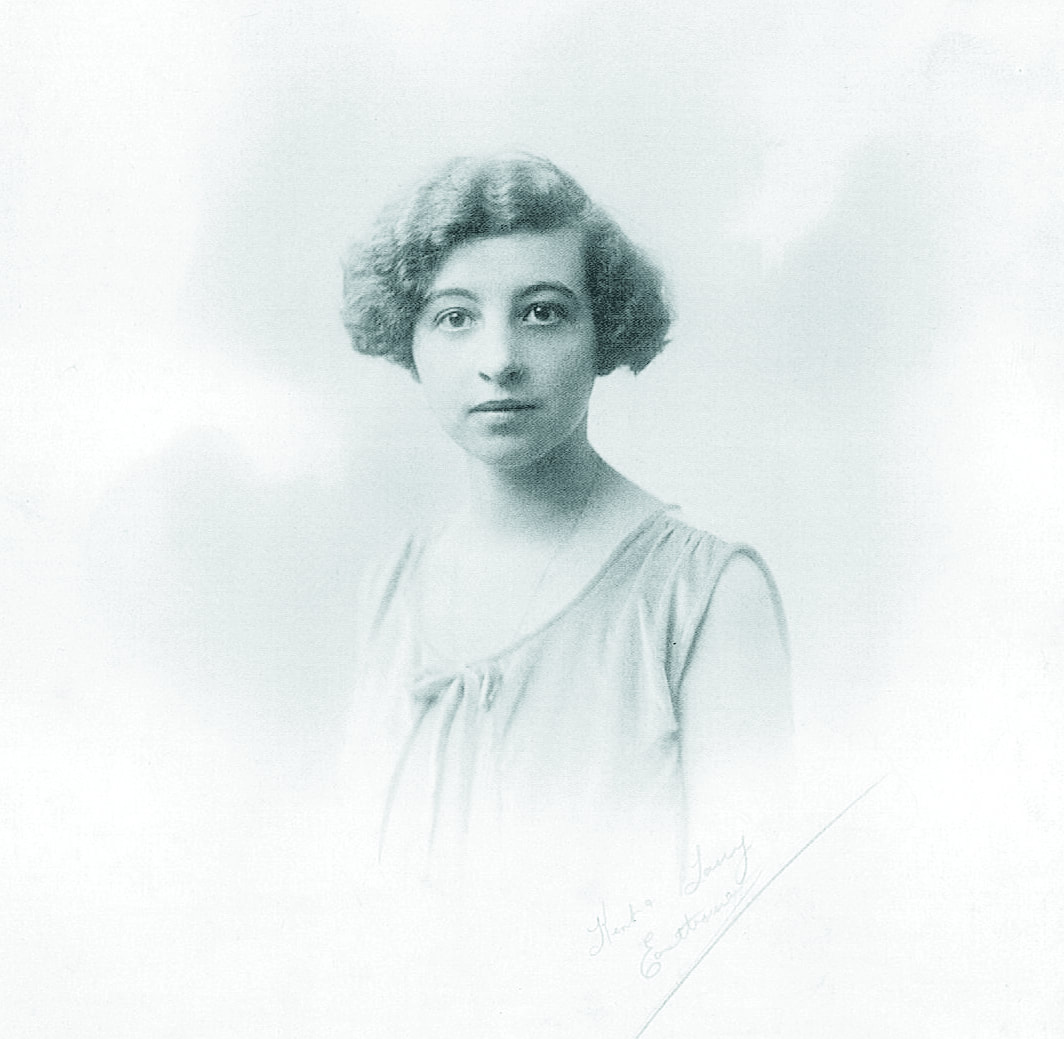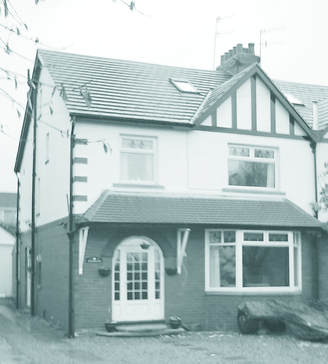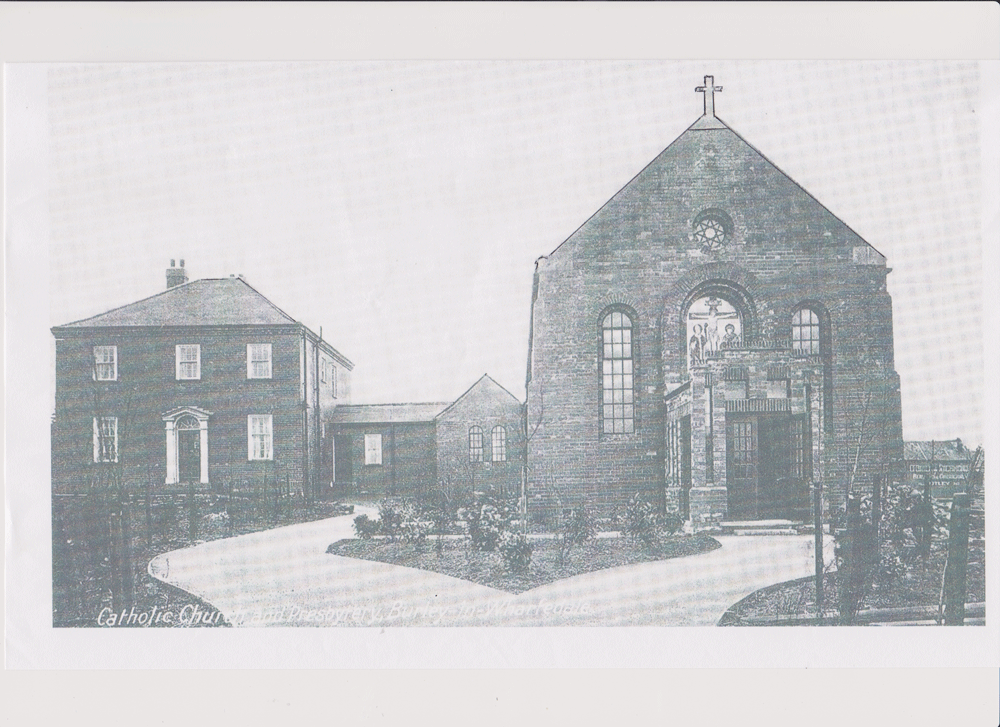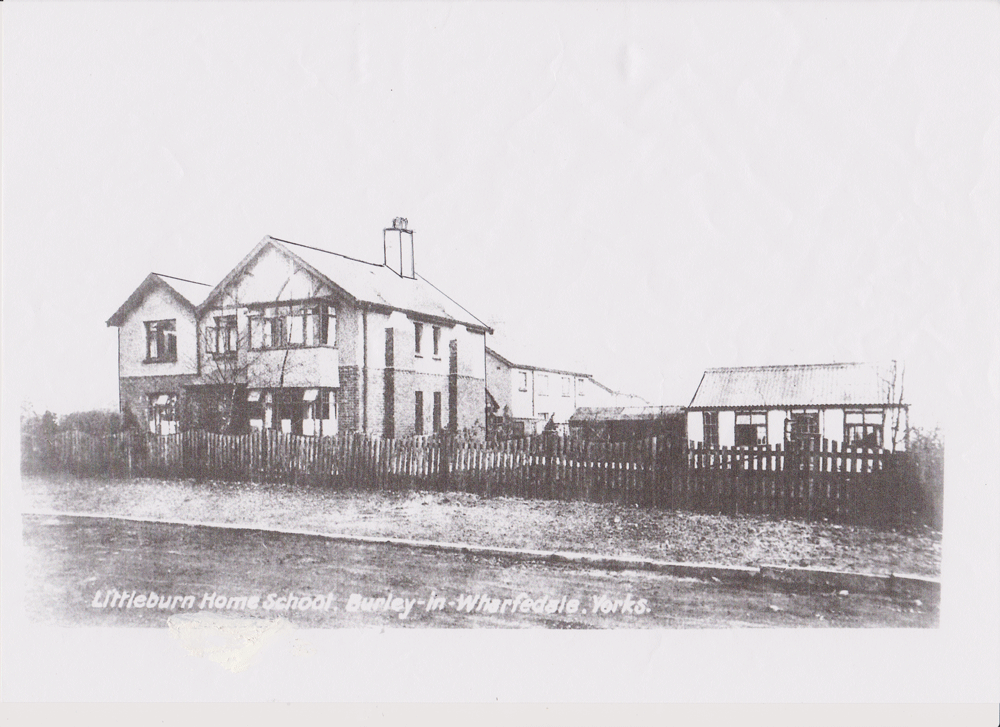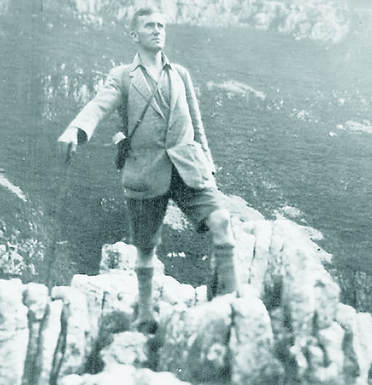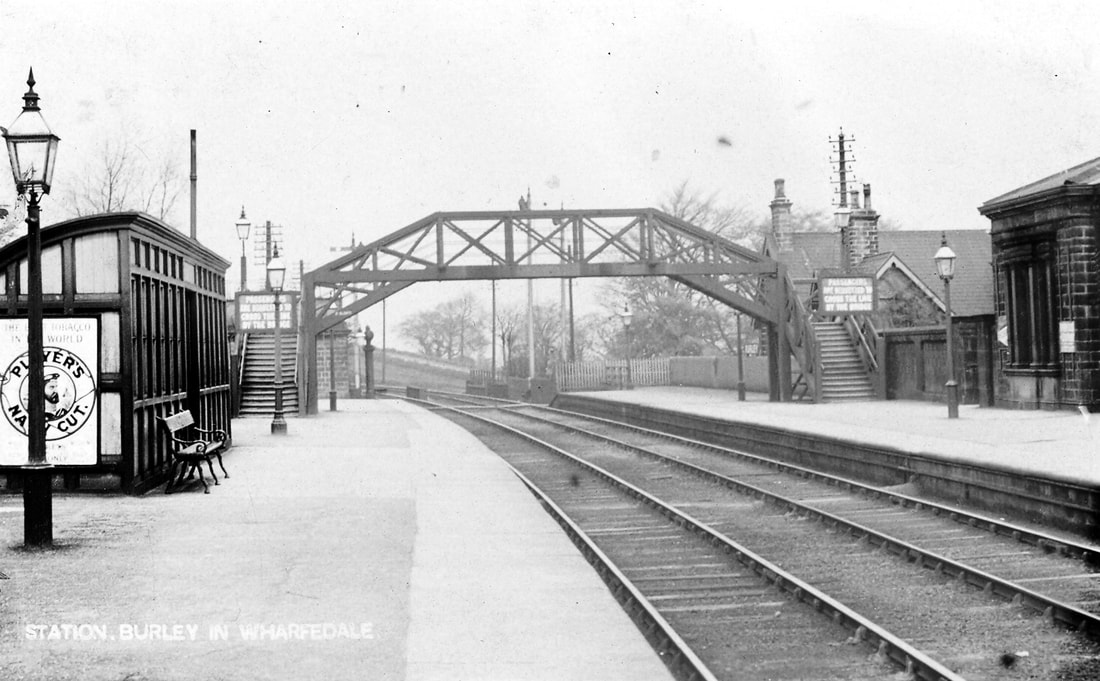The A.J. Brown Memorial Trail Around Burley-in-Wharfedale District.
Introduction
Alfred John Brown (1894-1969), prodigious walker, prolific writer and passionate Yorkshireman, was best known for his books about walking in 'God's Own Country' of Yorkshire. During the 1930s and 1940s he was one of the most popular and widely read authors about the Dales and indeed the whole of Yorkshire. He influenced whole generations of Dales lovers and walkers to explore the county of foot and became something of a Yorkshire icon in his day.
While he was born and bred in Bradford, where he worked as a sales representative in the wool trade, he was a resident in Burley-in-Wharfedale from 1927 to 1945. It was here that he was inspired by his time living in his favourite dale of Wharfedale. During this time he wrote his most notable series of 'tramping' books about Yorkshire, which even appealed to those 'armchair' readers who were not able to actually explore the County on foot for themselves.
The A.J. Brown Memorial Trail follows a 'figure of eight' route of about 6 miles (10 km) around the local Burley-in-Wharfedale district, which includes parts of the township of Burley and the edge of Burley Moor, as well as a section down to the River Wharfe. Along the way places of interest are identified, briefly described and illustrated which have particular associations with A.J. Brown and his family during their residence in Burley-in-Wharfedale.
Alfred John Brown (1894-1969), prodigious walker, prolific writer and passionate Yorkshireman, was best known for his books about walking in 'God's Own Country' of Yorkshire. During the 1930s and 1940s he was one of the most popular and widely read authors about the Dales and indeed the whole of Yorkshire. He influenced whole generations of Dales lovers and walkers to explore the county of foot and became something of a Yorkshire icon in his day.
While he was born and bred in Bradford, where he worked as a sales representative in the wool trade, he was a resident in Burley-in-Wharfedale from 1927 to 1945. It was here that he was inspired by his time living in his favourite dale of Wharfedale. During this time he wrote his most notable series of 'tramping' books about Yorkshire, which even appealed to those 'armchair' readers who were not able to actually explore the County on foot for themselves.
The A.J. Brown Memorial Trail follows a 'figure of eight' route of about 6 miles (10 km) around the local Burley-in-Wharfedale district, which includes parts of the township of Burley and the edge of Burley Moor, as well as a section down to the River Wharfe. Along the way places of interest are identified, briefly described and illustrated which have particular associations with A.J. Brown and his family during their residence in Burley-in-Wharfedale.
The Burley-in-Wharfedale Section
Start the walk at the Roundhouse on Main Street and follow the footpath diagonally across Grange Park into Grange Road. Turn left and continue for 80 m. then turn right into Grangefield Avenue, and stop outside house number 33.
|
Point of interest 1
In September 1927 Alfred moved to Burley-in-Wharfedale with his new wife, Marie-Eugénie (née Bull), after their honeymoon tour of Yorkshire, which included York and Whitby, along with the northern Dales, where they stayed at the Cat Hole Inn, at Keld in Swaledale and the Tan Hill Inn, above Arkengarthdale. They rented their first house at 33 Grangefield Avenue, which was then on the edge of Burley-in-Wharfedale, from which Alfred commuted to work in Bradford, while Marie-Eugénie became a housewife. In this modest little house a second bedroom served as Alfred's writing 'den', where he began work on his Yorkshire themed books. The first, Four Boon Fellows - A Yorkshire Tramping Odyssey (1928), was regarded as one of his finest pieces of writing by the critics. |
Continue to the end of Grangefield Avenue, then turn left along Langford Lane and continue for 200 m. At the left bend continue straight ahead on Langford Lane past St. Philip's Drive. Then turn right through a gate into Burley House Field and walk diagonally to a footbridge crossing Carr Beck.
Continue straight ahead to the stile/gate in the wall and emerge on to the Bradford Road (A65). Then turn right along the pavement and continue for 200 m past the petrol station and after 50 m stop outside the house named 'Wharfegate'.
|
Point of interest 2
Within a year Alfred and Marie-Eugénie were house-hunting again with the anticipated arrival of their first child, and in 1928 they bought their first home of 'Wharfegate', a one year old semi-detached house on the Bradford Road on the outskirts of Burley. At the time the house had uninterrupted front and rear views of wood-lined pastures leading down towards the River Wharfe, and up towards Burley Moor respectively. It also had an attic bedroom which became Alfred's new writing 'den', where he completed his famous Yorkshire 'Tramping' Trilogy of books: Tramping in West Yorkshire (1931), Tramping in Yorkshire - North and East (1932) and Striding Through Yorkshire (1938), which sold over 20,000 copies. 'Wharfegate' also became the Brown family home, which saw the arrival of all five of the Brown children with the births of Felicity (1928), Barbara (1929), Rosemary (1932), Christopher (1935) and Adrian (1944). |
Continue on the pavement for 50 m and stop outside the R. C. Church of St. John Fisher & St. Thomas More on the right.
|
Point of interest 3 The local church at which Alfred and Marie-Eugénie worshipped opened in 1932, so until then they attended the Sacred Heart of Jesus R. C. church in Ilkley. However with a church now on their doorstep, the Browns soon became closely associated with the new place of worship and its new parish priest. The church land had been purchased in 1930 by the retired civil servant, widower and late convert to Catholicism, Frederick LeFevre. Unusually he was subsequently ordained as a priest, became the church's first parish priest, and later he also provided support for the adjacent Memorial Parish Hall, which was named after his only son, Eric LeFevre. Fr. LeFerve also became good friends of the Browns, since he had some communality with Marie-Eugénie in that they both shared a strong French family heritage. Her maternal family name was Messe, and she had spent some considerable time living in France during early childhood and later during her adolescent years. |
Continue a short way along the Bradford Road to the junction with Menston Old Lane on the right then turn up the lane for 350 m to the junction of Endor Crescent on the left, and stop outside the house at the junction on the left known as 'Littleburn House'.
|
Point of interest 4 'Littleburn House' was previously the location of 'Littleburn Home School' which had been established by the two traditional educationalists, Miss Little and Miss Burn, hence the name of the school, that catered for boys and girls from nursery level up to eleven years of age. It was a 'P.N.E.U.' school, i.e. it was affiliated with the 'Parents' National Educational Union' which had been founded in 1892. The education provided centred on the individual child as a whole person, and delivered the broadest curriculum not merely the so-called three 'Rs' (Reading, 'Riting & 'Rithmatic), so that an individual's talents could be developed. In the 1930s the three young Brown sisters attended the school, which was then situated in a pleasant rural setting on the outskirts of the village of Burley. They, like the other children, particularly enjoyed playing on the open land opposite, which was used as an extended playground, along with the small stream of the now-channelled Mickle Ing Beck, which provided playtime pleasure for all the pupils |
Continue up Menston Old Lane for 50 m passing the site of the old railway bridge, which once carried the M&NER Otley & Ilkley Branch railway line, then turn immediately right, up onto the old railway embankment.
Follow the footpath for 350 m then turn left down the steep path, through two kissing gates and into the wood. Leave the wood through another kissing gate and follow the path up the field to the cattle arch. Go through through the cattle arch and carry on straight ahead to a kissing gate before a small beck. Follow the path over a small rise to reach a footbridge over Carr Beck.
Now bear left to follow the right hand side of the stream for 200 m, then through a metal gate and over a style before heading up the left hand side of the field. Continue to follow the course of the stream for 500m through three stone style gaps in successive field walls.
Cross the Ebor Way/Dales Way Link footpath between Bleach Mill (to the left) and Hag Farm (to the right). Refreshments are available on most days throughout the year from Bleach Mill. Go straight ahead on the footpath up through a wood following the line of Carr Beck in a ravine below on the left. After 200 m pass through a stone gap stile to follow a wall and fence on the left for 150 m to another gap stile, and then over a wooden bridge to emerge at a row of three storey cottages. Continue up the short steep tarmac road and arrive at Moor Road where a convenient seat is located.
Note: the route then crosses the sometimes busy Moor Road and caution is needed with blind corners to both left and right, before following the public footpath sign directly opposite up Green Lane.
The Burley Moor Section
Follow Green Lane for 750 m to reach York View Barn on the left, with The Shooting Lodge and Old Pumping Station on the right.
At this point on a clear day, there is a fine panoramic view over Wharfedale towards Otley Chevin (east), Almscliff Crag (north east), Askwith Moor (north) and middle Wharfedale towards Ilkley Moor (north west), while Burley-in-Wharfedale can be seen in the valley below. At the top of the farm roadway pass through a metal gate with a 'Welcome to Burley Moor' sign to the moor.
|
Point of interest 5 Alfred's outdoors interest began as boyhood adventures with his father and elder brother at weekends, when they walked via Shipley Glen to 'Dick Hudson's' pub near Eldwick, then over the moors to Ilkley for tea. But sometimes these exciting excursions ended in a moonlit return dash to catch the last tram home to Bradford! Later in his youth Alfred often tramped the moors around Bradford from Queensbury to Denholme, then via Oxenhope to Haworth, to explore the wild Brontë moors beyond. However after contracting diphtheria during WW1 as a gunner in the Royal Field Artillery, Alfred was medically discharged with a condition that left him semi-paralysed and unable to walk. It was almost six years before he fully recovered and learned to walk again following extensive convalescence at Beamsley in Wharfedale, and declared that: "walking was my cure and my salvation". His recovery became the driving force for his subsequent exploration of 'God's Own Country' on foot and the basis for his topographical writing. |
Once on Burley Moor turn right immediately along an undulating rough farm track and down past an old stone quarry on the left for 400 m to Crag Top Farm on the right. Then branch left on down a green path and descend via a rocky track to a metal gate leading to the Moor Road again. Turn right along the pavement and follow the road for 350 m to arrive at the historic Hermit Inn where refreshments can be obtained.
|
Point of interest 6
The Hermit, previously known as The Woolpack, was re-named after Job Senior (1770-1857), a recluse who lived on Burley Moor. It was Alfred's favourite pub and after his many excursions over the local moors, he often drew inspiration while planning his legendary Yorkshire 'tramping' books as he enjoyed the friendly conviviality of this historic inn. It was also here in 1932 that Alfred met the literary figure J.B. Priestley to seek advice about his own literary future. He had known the famous author from their earlier days in the Bradford wool trade, then after a meeting of the Bradford English Society on one of Priestley's rare visits to his home city, they exchanged correspondence about Alfred's literary aspirations. While Priestley admired Alfred's earlier works, he cautioned him against full-time authorship, since even as a bachelor, Priestley had struggled to survive in his earlier years, and suggested that with a family to support it was too risky a venture. With this sound advice Alfred continued his business career while writing in his spare time for his own pleasure and that of his readers. |
.
On leaving the Hermit Inn proceed via the footpath signposted 'To Burley-in-Wharfedale' at the end of the car park. Follow the tarmac drive down to a circular residential parking area and a pathway into a field through a gate. Proceed down the field with fence posts on the right, through an iron gate after 250 m and along a path at the side of a wood via two wooden gates. Cross a wooden bridge and over a stile into a field. Continue straight ahead for 200 m to join Hag Farm Road.
Turn left along Hag Farm Road passing The Gables house on the left. Then after passing Mayfield House on the right, ignore the footpath into a field ahead and continue along Hag Farm Road, which runs parallel with the railway line on the right. On approaching the railway station, take the path entrance on to the west-bound Ilkley platform and cross the footbridge to the east-bound Leeds platform, before making an exit from the station through the car park onto Station Road.
On leaving the Hermit Inn proceed via the footpath signposted 'To Burley-in-Wharfedale' at the end of the car park. Follow the tarmac drive down to a circular residential parking area and a pathway into a field through a gate. Proceed down the field with fence posts on the right, through an iron gate after 250 m and along a path at the side of a wood via two wooden gates. Cross a wooden bridge and over a stile into a field. Continue straight ahead for 200 m to join Hag Farm Road.
Turn left along Hag Farm Road passing The Gables house on the left. Then after passing Mayfield House on the right, ignore the footpath into a field ahead and continue along Hag Farm Road, which runs parallel with the railway line on the right. On approaching the railway station, take the path entrance on to the west-bound Ilkley platform and cross the footbridge to the east-bound Leeds platform, before making an exit from the station through the car park onto Station Road.
|
Point of interest 7 Alfred originally took the bus to travel to work and chanced to meet a fellow passenger reading one of his books, the artist William Littlewood, who worked as a technical illustrator in Bradford. He subsequently created the picturesque book cover illustrations for Alfred's books and also became a life-long friend. Later Alfred commuted to work by rail from Burley Station, but he noted that this mode of transport engendered less egalitarian behaviours among its passengers than bus travel. He observed that once on board train passengers separated into three social groups of contrasting demeanours, even though they had boarded from the same platform. There was an upper middle-class with a snobby 'reserved-ness', an intermediate middle-class with an uncomfortable 'in-between-ness' and a lower middle-class with a lively 'hobnobby-ness'. Typically Alfred mixed among the latter more sociable passengers with whom he found a kindred friendliness and fellowship. |
Turn right and continue down Station Road to the junction with Grange Road, then turn right until reaching the Burley Library and cross Grange Park to return to the Roundhouse.
The River Wharfe Section
Start at the Roundhouse again, turn right and go down to Main Street, opposite the Red Lion pub. Turn right and pass the Queens Hall. Note the prominent memorials to William Forster (1818 - 1886) and William Fison (1820-1900), and between them the wall plaque to the poet Sir William Watson (1858-1935).
Continue past the pedestrian crossing then take the next left turn along Iron Row, an attractive row of cottages built for mill workers about 1800. The route continues through the old stone gateposts for what was the mill entrance and passes the recreation ground to go through the subway under the A65.
The path rises gently to Great Pasture Lane. Turn left in front of the second set of old stone gateposts where there are good views on the left towards Burley Moor. As great Pasture Lane turns left into Great Pasture (a private road), go straight on at the bend to walk along the fenced permissive footpath. Along the path note the scale of the Greenholme Mill building on the right.
Go through a kissing gate and follow the footpath as it swings left down through the trees. Follow the broad path alongside the course of the redundant goit which provided water power to the mill. The goit and the footpath are owned and maintained by the West Riding Anglers Association.
The path follows the goit and passes a large green gate on the right. This is the entrance, over the bridge, to a hydro-electric generating plant (the stone building that can be seen through the trees). This is powered by the recently renovated goit which you are now walking alongside. A marked increase in the speed of the water is noted from here on. On the left there can be seen a raised, slightly angled stone slab in the field in front of Greenholme Cottages. It marks the site of Greenholme House, the Palladian Mansion built in 1820 by William Fison's father-in-law, Jonas Whittaker. It was demolished in 1923 and the stone was used to build the houses on Great Pasture. Continue along the broad track until a junction on the right, and turn right here over the bridge to view the impressive stone weir.
At this point the stepping stones, which were restored in 2013, can be crossed to the north bank of the River Wharfe to give access to a footpath and a bridleway to Askwith, as well as a number of walking routes through the Nidderdale Area of Outstanding Natural Beauty.
Note: Caution is needed if crossing the stepping stones since there are deep pools here and the river levels can rise quickly to prevent use of the stepping stones. Hence there is a long-running campaign by the Burley Bridge Association to have a footbridge constructed to ensure safe year round crossing.
|
Point of interest 8 The riverside was a favourite place of Alfred's to picnic with his young family in summer, and after a short walk from home they crossed the old stepping stones in the river to the grassy bank between the West and East Becks, where the children could play safely by the rivulets. The River Wharfe itself was also the recreational spot where Alfred often swam for relaxation. He would plunge into the large deep pool between the impressive stone weir and the stepping stones, where he enjoyed a vigorous, bracing interlude in the still waters. The river crossing was also part of Alfred's tramping route home on leave during his WW2 RAF service as an Intelligence Officer, whilst posted at the Air Ministry Training Centre in Harrogate. He walked some 18 miles via the Washburn Valley, stopping at the Timble Inn for refreshments, before descending Askwith Moor to cross the steeping stones. However on short leave he would always make the return journey by bus! |
Return to the broad track and turn right. The track now becomes a tarmac lane known as Leatherbank, and there are pleasant views eastwards towards Otley Chevin. Follow Leatherbank until as it turns around the Ghyll Royd School playing field, then go straight ahead to follow a path through another subway beneath the A65. Follow the path until it merges into Burley Main Street by a black and white cottage. Turn left and follow Main Street back to the Roundhouse.
Leaving Burley-in-Wharfedale
After his WW2 service, Alfred and his wife left Burley-in-Wharfedale in 1945 to buy the Whitfield House Hotel in Darnholme, near Goathland, on the North Yorkshire Moors, and operated a family-run country inn for nearly six years. During this time Alfred became a 'Literary Innkeeper' and published two books about the hotel experiences, a semi-autobiographical novel, a Yorkshire anthology, a book of poetry and a another topographical work about North Yorkshire.
On the strength of this literary output Alfred sold the hotel and embarked upon a risky full-time writing career, but after two relatively unproductive years in London and York, he found that he could not live by his pen alone. Economic necessity forced him to return to the Bradford Wool trade in 1954, and he travelled extensively as a sales director in Europe and the Middle East. Then in 1960 he established his own textile agency to represent UK specialist worsted manufactures' interests in Germany and Austria.
In 1967 Alfred and his wife moved to Sleights in North Yorkshire, where in semi-retirement, Alfred continued his agency work with his son as junior partner. However in late 1968 after he became ill on a business trip to Germany, he returned home and was diagnosed with terminal cancer. He died at home on 1 March 1969 and was buried in the St. John the Evangelist churchyard , Sleights, with a headstone inscription from his famous poem, 'Dales in Paradise', which reflects his eternal 'tramping' wish: "There must be Dales in Paradise, which you and I will find".
|
If you would like to know more about A. J. Brown’s life and literary works, John White published his biography in 2016 entitled: ‘Alfred John Brown, Walker, Writer and Passionate Yorkshireman’. It is available from Smith Settle, Publishing & Bookbinding Ltd., Yeadon, West Yorkshire, LS19 7XY, Tel: 0113-250-9201, Email: [email protected] or directly online via amazon.co.uk priced £15.00 plus £3.50 p. & p.
|


